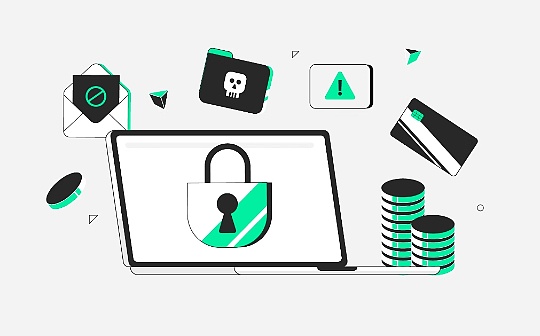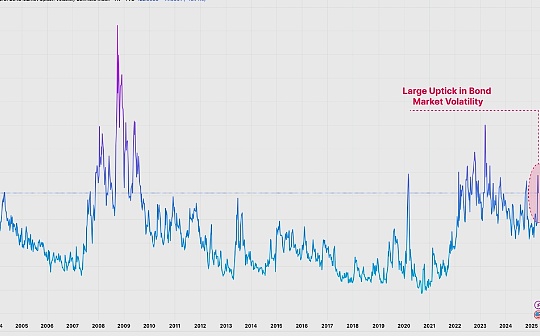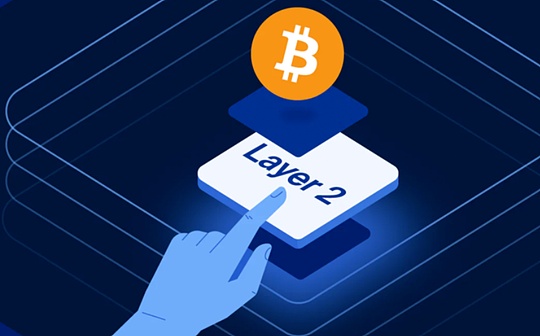
Author: blockpunk Source: X,@Blockpunk2077
I once mentioned,The great development of the “Inscription” has promoted the prosperity of the BTC ecology, but it has also exacerbated the competition of BTC network resources.The cost of too high Fee, the rise of the foreseeable BTC in the future, is also constantly increasing the entry threshold of BTC ecological players.
This has prompted people to discuss the expansion of BTC with more, which also attracted the attention of the community and investors.
Of course, people have tacitly avoided the expansion scheme of directly upgrading the BTC L1. The most radical discussion is nothing more than to remove some OP scripts seal and continue to dig the remaining potential of BTC under Taproot (such as CTV and CAT discussion).
In the development and theoretical results of ETH’s Rollup and modularity, BTC Layer2 has become the mainstream of expansion discussions and the fastest solution.The first batch of projects will also be launched in the next two or three months and will become an absolute mainstream narrative of speculation.
Due to the high decentralization of BTC governance, there is no “church” to guide the community, so its L2 design is also full of flowers.This article will start with a typical BTC L2 and related protocols in the market, a glimpse of the possibility of BTC expansion.
Here, the BTC L2 is roughly divided into side chains, ROLLUP, DA layers, decentralized indexes, etc., and explain similar projects that I think.The BTC’s capacity expansion scheme has no right to define, so my actual classification is not rigorous.
This article focuses on discussing from the perspective of partial implementation plan, and many designs are still in the paper stage.In the competition of the second -level assets, technology and security are absolutely the lower limit of the project.Technology is tickets, first -class, economy class and even hanging tickets. If asset speculation, as long as you reach the pass level.
>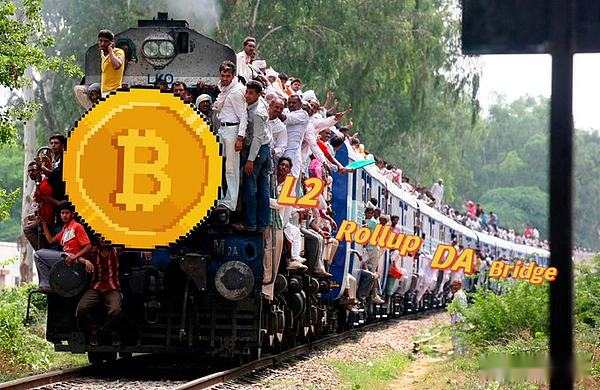
However, from the perspective of assets, one is the ability of L2 itself to create assets. Whether it is introducing inscriptions or pulling the plate by itself, it cannot be evaluated only from the technical level.Competitiveness, this is very important to value the safety of bridge connection. After all, “Not My Keys Not My Bitcoins” is the core doctrine, which is very related to the design of the scheme.
Will the adoption of the BTC ecosystem surpass ETH in the future?Maybe you can give you some reference.
First of all, you need to introduce the two changes brought by the front technology, Taproot upgrade:
-
Schnorr’s signature BTC introduces up to 1,000 participants with multiple signature methods, which is the foundation of many L2 bridges;
-
MAST allows a bunch of UTXO scripts to achieve more complex logic through the method of Merkle tree, which provides the possibility for the proof of the L2;
-
TapScript has upgraded the Bitcoin script and allows verification to verify a series of script to determine whether UTXO can be expected, which provides the possibility for L2’s withdrawal and penalties.
Side chain
In order to use it, it is everything.
The advantage of the side chain is to take effect quickly, mainly developing business logic.
Its security is basically only related to its network itself. It belongs to the “hanging ticket” on the BTC security. The most important part is the cross -chain bridge of BTC. This is the only connection point.
Btclayer2 bevm
In fact, most of the BTC L2 is the same as BEVM, continuing the idea of ETH expansion mid -chain.
BEVM has deployed a multi -signal address on the L1 of BTC through Taproot’s capabilities, and an EVM -side chain of the operator deploys smart contracts receiving BTC extraction requests in EVM.BEVM’s GAS uses BTC after cross -chain.
At the time of recharge, the operator of the bridge synchronizes the BTC data and notify the side chain. The BEVM node also runs the light client to verify the recharge of the BTC block header; when the withdrawal of the withdrawal, the custodian of the bridge will sign a certain number of signatures (after collecting a certain number of signatures (after collecting a certain number of signatures (Housing), the transaction of extraction BTC will be issued.This realizes the asset interoperability of the side chain and BTC.
Unlike the traditional $ RSK $ STX solution, BEVM uses Taproot’s BTC multi -signature to achieve the threshold signature. The manager of the bridge can theoretically more, which adds a certain fault tolerance to the BTC cross -chain and is more decentralized.
But BEVM does not use any security guarantee of BTC, only the BTC asset interoperability is achieved.Its node runs its own internal consensus and EVM, and does not upload proof on the BTC network, so there is no L1 DA.
The network transaction anti -review attribute depends on the network itself, so if the node refuses to pack your BTC withdrawal transaction, you will no longer obtain the BTC from L1, which is a potential risk.
The advantage of this method is that it can quickly achieve and verify. The taProot’s most of the TAPROOT’s self -implementation of the bridge is also further. It is the one of the few BTC -side chains of the main network on the online main network.
Mapprotocol Map Portocol
MAP is also a inscription side chain of the EVM architecture. Choose the BRC20 cross chain of the BTC L1 to the EVM to run some low -cost services.
MAP runs a enhanced BRC20 indexer. Users cross -chain BRC20 from BTC need to send new transactions to insert information such as the target chain, target address and other information in JSON, which is indexed by MAPThe signature committees under the MAP POS mechanism have issued more BTC transactions.
BRC20’s ledger actually runs in the index, and BTC L1 is essentially its available data source.
Using the low cost of the side chain, the MAP chain runs the MIC20 MINT tool LESSGAS, and the inscription market SATSAT, and the cross chain of the BRC20 via ROUP.The idea with the inscription is quite distinctive, attracting a group of users.
MAP uses a classic POS consensus mechanism to upload checkpoint data from BTC L1 to enhance its security.However, in addition to preventing long -range attacks, MAP still does not use BTC’s security guarantee, and has not enhanced the withdrawal of withdrawal, status change verification, and data reliability in anti -review.
Bitmaptech Merlin Chain
BTC side chain released by BRC420.Merlin Chain chooses to use the MPC scheme of the Cobo wallet to achieve the cross -chain of BTC. This seems to be a relatively conservative choice: the number of MPC signs is small, compared to the Taproot upgraded BTC more signature, there are still some security in terms of security.The gap, but fortunately MCP has been verified for a long time.
Merlin uses the account abstraction of ParticLENTWRK. You can continue to use Bitcoin’s wallets and addresses to interact with the side chain without changing user habits. This is worthy of praise.In contrast, let Bitcoin users return to Metamask to interact, this design looks lazy and simple and rude.
BRC420 and Bitmap are high enough and have accumulated many user groups.Merlin continues to carry out business around the inscription, supports a variety of inscription assets from the cross chain of L1, and provides new inscriptions on the side chain.
dfinity CKBTC
CKBTC is a cross -chain integration of BTC in ICP through pure cryptographic schemes, and does not rely on any third -party bridge or hosting.
ICP is an independent L1 blockchain, which is guaranteed by its unique BLS limited signature scheme.CHAINKEY technology, which is bound to the consensus algorithm, allows the entire network of ICP to jointly manage a BTC’s retarded signature address, accept BTC, and control the BTC under this address through consensus aggregate signatures to achieve withdrawal.
ICP is also in its own network. It uses the account model to restore all the UTXO of BTC. The smart contract in the network can read the status of BTC, which is about to run the BTC full node in the ICP network.
Because this threshold signature is directly bound to the consensus algorithm of the ICP network, the security of CKBTC is only related to the ICP network and the BTC network, and the additional third -party trust assumptions are not introduced.
Therefore, the CHAINKEY retarded signature scheme used by CKBTC’s ICP is currently the safest BTC bridge idea.But for the withdrawal of the withdrawal, if the IC network is dying or rejected a transaction, it will not be able to force the withdrawal from the BTC L1.At the same time, ICP is independent L1, and security is guaranteed by itself, which has nothing to do with BTC.
Data usability
BTC is the most stable and trustworthy data source in the world. None of them, so the use of Bitcoin as the source of credible data becomes very granted.
Similarly, with the theoretical basis of Celestiaorg’s DA, although the data storage of BTC is very expensive, it also has a consensus foundation as a DA layer.
In essence, Ordinals and the entire inscription ecology actually use BTC as DA. Almost all “BTC L2” will send data to BTC, but this is more like a formalism and represents a beautiful vision.
Here are some distinctive designs.
nubit_org nubit
Nubit is a DA protocol for BTC extended data availability scenarios, because its financing has the participation of Boundce Finance and Domo.
Simply put, Nubit organizes a DA chain similar to Celestia by running POS consensus, and regularly uploads Nubit’s DA data such as block head heads and trading Merkel tree roots to BTC L1.
In this way, Nubit itself is saved by BTC L1, and Nubit sells the storage space on its own chain as DA to users and other Rollup chains (DA sets).Nubit has no smart contract capacity and requires ROLLUP based on its DA.
Users upload data to Nubit’s own DA layer. After confirming the POS consensus of Nubit, these data will enter the “soft confirmation” state, and Nubit will upload the chain data root to BTC L1 after a period of time.Later, the data that was initially uploaded to Nubit would enter the final confirmation state.After that, users need to go to the label of uploading data in BTC L1, which is used to query the original data in the Merkel tree of Nubit nodes.
The POS consensus of the Nubit network was supported by BABYLON’s BTC POS pledge (will be introduced below).
The user uses BTC to pay the storage fee. To this end, the Nubit uses the lightning network to accept the BTC. The status channel does not have a bridge problem. Users can cancel the channel for emergency withdrawal and do not need to trade with the Nubit POS network itself.
It seems that Nubit seems to be a bitcoin ecological version of Celestia. It does not add complex smart contract functions. It is also the most centralized lightning network for BTC payment, which is relatively simple.Although the Lightning Network is enough to trust, the experience of using is not good enough, and it is difficult to support the in and out of large funds (the status channel exhausted).
The relationship between Nubit and BTC is relatively thin. The security of the chain itself is not guaranteed by the BTC. The data on the BTC is only verified by the Nubit node client.
Why does ROLLUP and inscription data need to go to the nubit packaging layer without uploading it directly to BTC?This may be the most important question that Nubit needs to answer, and the low cost may not be used as the core driver.
Relative to BTC DA’s biggest advantage, it may be that Nubit’s DA supports the sampling data verification (DAS) of light nodes, which cannot be achieved by the BTC network, which means that the verification of DA no longer requires users to download BTC’s entire node.
Can no longer be the inscription of Fully-On-Bitcoin, can they still get community consensus?Nubit tries to replace the DA of the BTC L1 chain with its own chain. It may not be a technical question, but a huge challenge for community consensus.Of course, this is also a huge opportunity.
Veda_bitcoin veda
The VEDA protocol reads a specific Ordinals burner on BTC L1, which uses it as a transaction request and executed in the EVM under the BTC chain.
The user signed a transaction that conforms to EVM on the BTC L1 private key, and then cast it on the BTC as an inscription.VEDA’s EVM node scan the BTC block. Once the transaction is confirmed by the BTC, the EVM will execute the request to produce a state change.
In fact, this is to treat BTC as VEDA EVM to be confirmed.However, because the performance of BTC is much lower than the EVM of ETH, and the data written in the BTC block in a certain period of time is limited, VEDA EVM can definitely execute all EVM requests uploaded to BTC.
BTC is a data source in all states of VEDA. Anyone can restore the complete state of EVM by scanning the VEDA request in all BTC blocks.Therefore, you can optimize the VEDA EVM without any complex security assumptions.
However, VEDA cannot expand the performance of BTC.Veda can be regarded as a block interval for 10 minutes, TPS is 5, but Ethereum network with tens of thousands of nodes and huge POW computing power.
It just expands the function of BTC and adds smart contract capabilities.This does not solve the problem of resource competition essentially.
babylon_chain babylon
BABYLON is an agreement to help other blockchain share BTC security. This package has two parts, Bitcoin pledge service and Bitcoin timestamp service.
BABYLON allows the BTC to provide a economic security guarantee for the POS chain (similar to ETH’s RESTAKE). The pledge process is fully running in a cryptographic manner, and does not need to rely on any third -party bridge and custodian.
BTC pledges can send a transaction with two UTXO outputs on the BTC to achieve pledge. The first UTXO writes a time locking script.With a temporary Bitcoin address, the public -private key of this address meets the cryptography standard of “extraction of one -time signature EOTS”.
When the BTC pledker runs a POS chain node, the only effective block is verified, and the EOTS private key signs it.
If the pledker (also the verificationer of this POS chain) remains honest, and only sign one effective block each time, it will receive the verification of the POS chain; if it tries to make evil, sign two at the same level at the same level of the block heightBlock, then its EOTS private key will be pushed out. Anyone can use this private key to transfer the pledged BTC on the BTC chain to achieve a penalty.In order to urge the pledges to maintain honesty.
BABYLON also provides a BTC timestamp service, that is, upload data from the checkpoint of any blockchain to the OP_RETURN of BTC, thereby increasing security.
The above Nubit plans to use Babylon’s BTC pledge service to strengthen security.BABYLON is not on the access and penalties of BTC, and the solution of pure cryptography is used, which is very safe.However, for the chain of pledge service, this has restricted at the economics level, compared with ETH’s Rollup method, etc., there are some distances in verification.
Although the timestamp service uploads L2 data BTC, it is necessary to directly check that the entire BTC block needs to download the full node, and the threshold is high.At the same time, BTC L1 has no smart contracts and cannot verify the correctness of these data.
Rollup
Through Ordinals, Bitcoin can store various data and become a highly secure database.Uploading Rollup’s proof data to the BTC network can indeed ensure that it cannot be tampered with, but this cannot ensure the effectiveness and correctness of the Rollup internal transaction.
The core problem of BTC Rollup is verification.
Most BTC Rollup may choose the method of sovereign Rollup (client verification), the verifier synchronizes all the data of Rollup under the chain and check it by themselves.
But this cannot use Bitcoin’s strongest capabilities, that is, the POW consensus of hundreds of thousands of nodes to ensure the security of Rollup.The most ideal state is, of course, the BTC network can actively verify the proof of Rollup, like ETH, and refuses to drop invalid block data.
At the same time, it is necessary to ensure that the assets in Rollup can be trusted to extract the BTC network in the most extreme cases. Even the node/sorter of Rollup has been down or refused to accept transactions, and it can still be removed through a safe escape channel.
For BTCs without smart contracts and only scripts, they may use MAST’s ability to combine the script into logical circuit to achieve verification. Although it is difficult, it is the most native idea of BTC.
Zerosync_ Bitvm
BITVM is the most watched expansion protocol on BTC, and it is an Optimistic Rollup of BTC.
Bitvm innovatively proposed a way to fraud on BTC. The proofers and the challenger are stored in a transaction with the same number of BTCs for gambling (as input), and this transaction output will contain a logicCircuit.
The BTC script can be regarded as the simplest logic door to process the simplest logic. The logic door is the most basic component of the computer.If the logical door circuit is combined with each other in a tree -shaped manner, it can form a circuit with a specific logic (you can imagine the computer of Qin Shihuang in the three bodies).
>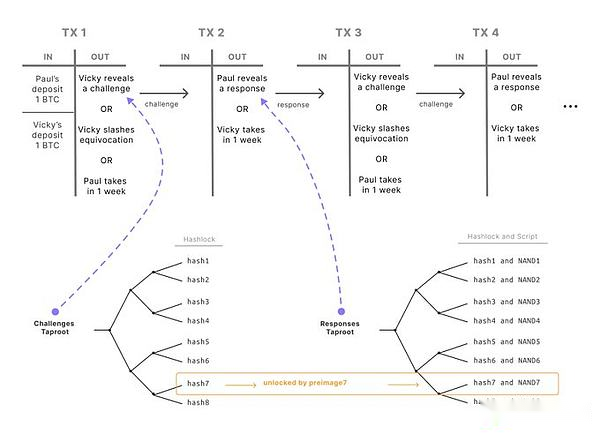
Bitvm is written into a fraud certificate in a large number of BTC scripts, which is determined by a series of nodes packed by the discharge in Rollup.
The challenger can constantly upload the hash value to the fraud proof circuit, and the verifier continues to run the corresponding script, and reveals the output to confirm that the results are correct.
Under a series of transactions, the challenger can constantly challenge the proof, until the proofer confirms that each circuit door is correct.As a result, the BTC network completes the verification of rollup, and the proofer can understand their own funds.Otherwise, the challenger will get the BTC pledged by the proof.
In a good way of understanding, the relationship between Bitvm and BTC seems to be like OP to ETH network, and its security is the highest among all expansion schemes.The number of transactions generated by BITVM is very large and costs expensive. Before participating in the chain verification of both parties, a large number of signed nicknames are required, that is, a large number of chain calculations are required.
Of course, unlike ETH’s Optimistic/ZK Rollup, Bitvm does not have an emergency BTC withdrawal channel, and at least one honest node in the L2 network can complete the normal exit.However, this is the highest security guarantee that BTC L2 can achieve at present. Uploaded by DA, BTC L1 verified the effectiveness of the Rollup data, trusted to minimize the BTC bridge, but lacks the “emergency escape channel”.
Therefore, the realization of BITVM looks far away, but recently the discussion of the BTC community on lift OP_CAT script may bring new possibilities to the development of BITVM.OP_CAT operating codes can be linked to the two string of the river, which supports up to 520 byte length.The series of this data can achieve more complicated calculations on Bitcoin.For example, BITVM can connect hundreds of logical doors under the same script, which allows Bitvm to process more binary circuits in less transactions, which has almost a hundred times the growth rate.
Bitvm has also inspired many L2 projects in the complex combination of Bitcoin script, and based on this, it has proposed the idea of new challenges to “fraud” challenges on BTC.
Bison_labs biscing network
Bison Network is a Bitcoin-based ZK-Stark sovereign Rollup (client verification).
The so -called sovereign Rollup, that is, L1 is used as a block data publication board (DA) for Rollup. It does not verify whether the rollup transaction is correct, and the rollup transaction is verified by Rollup’s own node.
Bison submits Rollup’s ZK to BTC Ordinals. Users can download proof from BTC and run their client to verify Rollup transactions.If you need to verify the entire state of rollup, you need to synchronize the whole node.
The characteristics of Bison are the realization of the BTC L1 bridge.When a user saves BISON ROLLUP BTC, this BTC will be assigned to multiple packages of BTC’s multi -sign wallet.These multiple -signing wallets support DLC (Discreet Log Contracts). This technology is based on Taproot upgrade. It is a simple logical contract that uses BTC multi -visa and time lock script.
When users deposit in BTC, they need to sign related execution transactions with BISON networks with BISON network, such as:::
-
Transfer to others
-
Extracted the situation of the BTC main network
-
No one extracted for a long time.
After the signing, these transactions will not be published in the BTC block. If the transaction wants to execute it, it needs to be driven by the prophet.There are three controlists who sign for more wallets, namely users, bison rollup, and prophecy machines. Get any two of them to obtain these BTC control.
DLC is like the IF-DO statement on Bitcoin. The prophecy machine comes to enter the IF condition. The execution part of the do is to send the transactions in the three cases signed above.
The prediction machine link here is the bridge contract of BISON ROLLUP.
-
The transaction signed down, the multiple signature address control is given to the BISON network to further allocate it; if the user’s request is received, send it
-
Control is transferred to users; if the message is not received for a long time, the time is locked and the control is returned to the user.
As a result, BISON realized the extraction of BTC from Rollup and set a simple escape channel.However, the weakness of the system here is the prophecy machine. If the error message is passed, the assets of the user will be lost. Therefore, you can consider introducing decentralized parts, such as ChainLink.
The “Bridge of Trust” implemented by DLC is the excavation of the BTC script potential. Http://dlc.link use it to span the BTC into the ETH and STX chain.
Although Bison Rollup has achieved a simple “escape channel” through the introduction of new third parties, it still has not implemented BTC L1 verification rollup proof.
Bsquarednetwork b² network
B² Network is a ZK Rollup mixed with the “promise challenge” on BTC.The network is divided into two layers, the Rollup layer and the DA layer.
The Rollup layer uses ZKEVM, running smart contract logic. This layer contains multiple modules, which includes transaction acceptance, sorting and packaging, ZK’s output, supporting BTC address account abstraction, and reading BTC L1 data simultaneously (More than 20 BTC and BRC).
The DA layer provides data storage for ROLLUP, and the storage node conducts the ZK verification of the ROLLUP transaction.After completing the verification, the DA layer node writes the Rollup data into the Ordinals inscription of BTC.Essence
The verification of proof is the core.The joint contract is directly verified on the L1 to verify the ZK certification, and there is no smart contract function on the BTC. Due to the complex logic of ZK verification, the logical circuit of the verification verification by the combination of the BTC script (the cost may exceed the BTC block of the BTC blockThe upper limit).
Therefore, B² introduces more chain calculations in the verification, and transforms L1 to ZK directly to a “fraud certificate” challenge similar to Optimistic.B² decomposes the zk’s proof into different scripts, and these scripts are superimposed into MAST binary tree.B² nodes sent BTC through this transaction as a reward for fraud.
>
Once a transaction containing a “fraud certificate challenge” is confirmed on the BTC L1, the challenger can download the original data from the DA layer and execute the above script under the chain.
If the final output is inconsistent with the submission of the B终 node, it means that the node is evil, and the challenger can get the control of the node in the script root, and at the same time, the Rollup transaction will roll back.
If there is no challenge during the lock time, the node can retrieve the locking BTC, and Rollup gets the final confirmation.
In B² Network, the first transaction that was issued to be issued confirmed that the ZK certificate was not tampered with.Although BTC still cannot verify the ZK transaction, through the “fraud certification challenge” in the second transaction, the verification of L1 is indirectly completed, ensuring the effectiveness of the transaction under rollup and increasing security. This is indeed bright.Innovation.
B² Network introduced account abstraction. Without changing user habits, let everyone use BTC’s wallet directly to interact with Rollup. This is a very praised place.However, from the extraction of BTC assets from L2, the method of multi -signal address bridge is still used, and the “escape channel” is not introduced.
Satoships satoshivm
Satoshipm is also based on BTC -based ZK Rollup. Its logic is similar to B² Network. After generating the ZK proof in Rollup, the proof of the proof will be uploaded to the BTC network before sending a “fraud certificate” challenge containing BTC.The person will get BTC rewards.
The difference is that SatoshivM added two time locks in the “fraud certificate” challenge, the corresponding challenge start time, and end the world with the challenge. In this way, how many blocks are waiting for the transition of BTC, you can personally send the ZK certificateWhether it is correct and effective.
The part of its cross -chain bridge is actually only using multiple signed solutions, and there is no bright spot.
chainway_xyz chainway
Chainway is a BTC’s ZK sovereign Rollup. It not only uses Bitcoin as the release layer of data, but also uses BTC data as the source of the production of ZK.
Chainway proofers need a not leaky scan to scan each BTC block.Read the block head from the BTC block, the previous ZK Proof, and the “forced transaction” carved in the block to generate a complete ZK Proof.In each BTC block, Chainway submits a trading of a burning ZK Proof to form a recursive proof.
>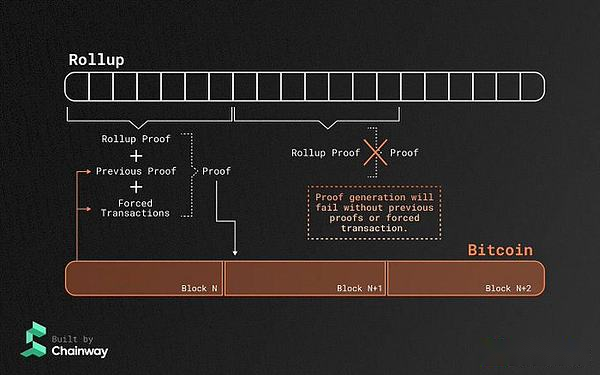
In the BTC block, the “mandatory transaction” engraved in the form of the ORDINALS inscription is the “anti -review transaction sending method” set by Chainway.If the Chainway Rollup node is down or has always refused to accept the extraction transaction from the user, the user can directly engraved the withdrawal request into the bitcoin block.The nodes must include these “mandatory transactions” into the block of Rollup, otherwise it will not be able to meet the constraints of the ZK circuit, and the Proof generates will fail.
On the latest Twitter, Chainway claims to be inspired by Bitvm. They have found the method of verifying the ZK certification on Bitcoin to achieve the settlement of BTC L1.
Obviously, Chainway’s current design is based on the client of the sovereign Rollup.Although the “mandatory transaction” solves the problem of anti -node review of the Rollup transaction to a certain extent, it is still impossible to achieve the real BTC L1 asset settlement.
Qedprotocol qed protocol
Qed Protocol is a ZK Rollup on BTC, which runs based on ZKEVM.Unlike other ZK Rollup, QED did not choose to generate ZK Proof for the entire Rollup transaction, but created ZK Proof only for the withdrawal transaction from Rollup to BTC L1.
Similar to BITVM’s ideas, Qed Protocols forms a logic circuit to verify the ZK Proof of the withdrawal of withdrawal transactions on the BTC L1. Such logical circuits will include 1,000 UTXO. Although it is directly verified, the cost cost is huge.Essence
Facing index programming
If you trace the roots, the BRC20 is essentially a BTC L2, and the transaction data of the BRC20 is recorded on the BTC, and the ledger actually runs in the indexer under the chain.
Although the current BRC20 ledger itself is completely centralized, we rarely worry about its security, because the BTC network’s Ordinals cannot record all transaction records, anyone can scan the BTC network to restore out the BTC network, thereby restoration outThe state of BRC20.
However, this expansion only adds new features to BTC, which is not helpful to expand its performance.If the ledger in the index device is decentralized, can it innovate an inscription chain?
In fact, the follow -up business launched by@unisat_wallet is the idea of $ SATS. Swap and Pool are implemented in its indexes. If you want to obtain the consensus of capital security, decentralization is an inevitable process.
There are also @Roochnetwork do not obtain assets from L1 at all, but only running indexes and BTC full nodes, and only read -only L2 used by read data for smart contracts on the chain.
at last
Of course, there are many items that I have not introduced, partly because of unknown descriptions, part because I have limited energy.
The industry is changing rapidly, and every second has a new BTC L2, but it is the inevitable trend of the BTC ecology to the second floor.
BTC is a train that everyone wants to pick up. From the perspective of the plan, the side chain is the passengers who bought the tickets. They only use the cross -chain bridge to contact the BTC, but they can be used earlier.
The DA type project is a BTC version trying to build Celestia and Eigenlayer. It is enough to make a gimmick. There is also opportunities for modularized extensive consensus.
And Rollups upload DA and use the BTC script to implement some simple BTC chain mechanisms (most of them borrow from Bitvm’s bit commitment thinking), barely counted as half of the BTC security compartment.Who said that Rollup relied on self -verified sovereignty is not rollup?(All need to thank Celestia for long -term CX for sovereign Rollup)
The gemstone on the BTC L2 crown is to use the BTC script logic to verify the proof of Rollup upload. At present, only Bitvm and #atomicals AVM are trying, which is infinitely close to ETH’s security relationship in its Rollup.At present, it seems that it is out of reach at the level of implementation, but the unsealing of new operators such as OP_CAT seems to be able to further accelerate its process. Bitvm may be realized faster than everyone estimates.




